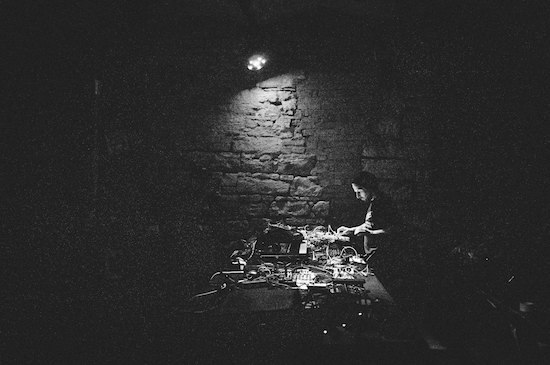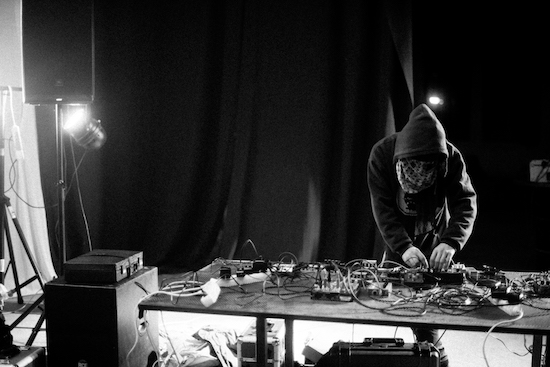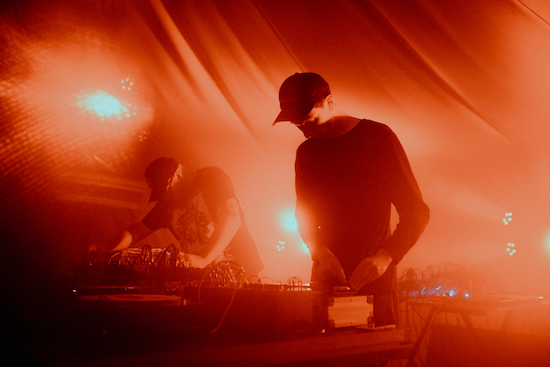Jasnovidec by Anna Bartolotti
“I look into the distance to the end of the world,” narrates the opening monologue of Herz Aus Glas (1976) by German director Werner Herzog.
Words are uttered by the hermit and mystic Hias, who can prophesy from nature, “Now I focus on one point in the waterfall. I’m looking for one point where my eyes can rest.” He’s sitting in a meadow somewhere in the Alps, and as he speaks, we are captivated by the mesmerising shots of the roaring waterfall and the rich landscape of surrounding forests — until one wants to be absorbed by the trees and vanish.
In contrast to the meditative tranquillity of the landscape, there is tension and hustle down in the village. It underlines the chasm between a hectic civilisation with a constant emphasis on progress and unchanging, enduring nature.
In the local glassworks, the master died and with him, the recipe for rare ruby glass disappeared. The business owner is uneasily trying to produce the substance, but all attempts end in vain. The locals go to a clairvoyant Hias for advice, but they don’t listen as he predicts a near catastrophe in the village…
The legend goes that all the actors were in hypnosis during the filming, and the movie itself has a strange slow atmosphere as one prophecy is fulfilled after another.
No wonder it was exactly Hias’ prophetic monologues, which are in Herz Aus Glas underlined by the psychedelic music of the German krautrock band Popol Vuh, that inspired the Czech collaborative project Jasnovidec (The Clairvoyant).
On the recent eponymous record of two underground artists Michael Nechvátal and Daniel Jakeš they use modular synths to build pensive kosmische, sometimes it is a ruinous harsh noise, a hypnotic drone, or a soothing dark ambient. The album by two synth nerds provides a space for contemplation similar to that found in Herzog’s film.
“Because of those beautiful static shots, we wanted to get some rigidity on our record. The film shows a contrast between the eternity of nature and human grimaces chasing after some stupidity, material stuff, or more money — and it doesn’t matter if it’s ruby glass or something else. It’s still a complete downfall,” explains Jakeš, who otherwise makes noise under the nickname Koroze, “The nature is not dark, rather is everything around.”
Noise Adolescents
The album Jasnovidec (2020) was made during a two-day session last December, but the actual ideas flourished during joint trips to the woods. Both musicians slept under the stars, drank tea, and talked by the fire late into the night.
“On trips, we talk about technology and approach. Without the time spent together building mutual understanding, it would not be possible to do this,” says Nechvátal, who also records under the name Kult Masek (Cult of Masks): “Besides, there is the repetition in walking, which we then translate into the music. The drone offers a wide range of ways to portray it.”
Jasnovidec takes a sense of repetition and a motorik beat — sometimes evoking a trance — from a trustworthy source: German krautrock bands such as Neu!, Can or Harmonia. Nechvátal further explains the division of labour. He creates somewhat calmer, more ambient passages, which opens, for instance, the track ‘Dolmen’. In the middle, however, Jakeš takes the initiative, and the track breaks into a harsh noise full of distortions.
“My roughest is close to Daniel’s quietest. We also learned how to exchange roles,” comments Nechvátal. Although both players represent two opposite poles, at least in the intensity of the sound, a common musical appetite ranging from the organ drones of the Swedish composer Ellen Arkbro to the do-it-yourself noise of the American musical handyman Jason Crummer unites them. And like Crummer, they both have their roots in the punk scene.
Jakeš has a history of playing in hardcore bands and the name of his most recent group — Antisocial Skills — perhaps best captures his reasons for transitioning to noise. The complicated agreements and intense social contacts generated by life in the band had become a problem and he no longer enjoyed the sometimes unmanageable and intense emotional relationships this lifestyle generated.
Instead, he withdrew to the shell and relied on himself: “I stopped being able to cope with being in the group. I didn’t want to rehearse. Moreover, I haven’t listened to hardcore or punk for a long time, and I think it started to affect my work in the band. I no longer felt that interest, I didn’t want to be an obstacle, and I was also struggling with mental health problems. I don’t have to negotiate with anyone today, and the result is that I spend a lot more time with music than ever before.”
On the other hand, Nechvátal alias Kult Masek started as a loner making music at home on his computer and with the help of the internet, and various compilations he got into the local DIY music scene. In between hardcore, or chain punk stuff, he looked inappropriate with his synths and ambient music. Still, over the past decade, more and more people from these circles started experimenting with synthesizers as well.
Two solitaires suddenly found themselves in the middle of a newly emerging scene of related loners. Some are close to the idea of uncompromising noise, others to a soothing ambience, but they have a common background in hardcore, are in their thirties, are united by a desire to explore sound possibilities, a strictly DIY approach. Perhaps surprisingly for some — they also share a sensitivity to nature and reflections on environmental themes.
Nechvátal and Jakeš, recording solo as Kult Masek and Koroze, met two years ago on the compilation Noise Of Today: New Wave Of Czech And Slovak Noise, which was a kind of manifesto of the new scene. The sticker on the cover displayed a daring but necessary sentiment from a Czech POV: “Guaranteed Kopel Free”.
It’s an outline of a split that happened between the old and the new noise, personified by the veteran of the domestic noise scene Radek Kopel. His activities date back to pre-revolutionary Czechoslovakia in the 80s where he learned about metal from smuggled-in records and the hunt for harder stuff led him to industrial noise. The most significant influence on him was Einstürzende Neubauten, who came to Czechoslovakia in 1987, but the police dispersed the show and the only band visiting from West Germany who finished their set was Die Toten Hosen.
Probably no one in the past thirty years has done more for domestic noise than Kopel, who has worked under various names and released countless compilations. Best known, however, is his band Napalmed, in which he has been active since 1994 and which, among other things, released the split record Clash Of The Titans (2001) with the Japanese noise pioneer Merzbow.
“It’s such an allusion to the strong slogans and statements in the style of ‘New Wave of British Heavy Metal’,” says Jan Šamánek, who co-released the compilation on his label Coffee Breath Records and is engraved in the tracklist as Talk=Trouble. Šamánek describes the difference between the new and the old wave, where the noise was mainly instinctive, the concerts verged on with the theatre performance, and it could easily happen that someone hit you with a steel traverse or a pipe from the scaffolding.
“We don’t do any performative and confrontational art, we don’t record tapes in a cassette player, and we don’t make noise with drills,” says Šamánek, “We are more into sound. Although our music is aggressive, it is more introspective, certainly not exhibitionist. You don’t have to worry about the bottle of piss landing on your head at our concert.”
One of the most active local figures of noise is a guy called NBDY, who oscillates between the old and the new wave, and he also took part in the release of the compilation. He grew up on noise releases by Kopel, but he retains a certain uprooting as a kind of guild privilege: “This is not a definition, it is simply something like before Christ and after Christ. We announce that noise adolescents are coming.”

NBDY by Miloš Potužák
Until It’s A Fire
Talk=Trouble and NBDY also grew up in hardcore. “There is energy and intensity in that music, but as you get older, responsibilities come along, and you don’t meet new friends, so you have to do it yourself,” Šamánek who is in his mid-thirties describes his journey to synthesisers as a pragmatic choice.
In a few years his collection of gear has grown in size, and he has to store machines in his basement and garage, as well as at his parents’ place. While Talk=Trouble still maintains contact with the HC scene and plays in the bands Remek, Protijed, or Gattaca, NBDY reached a natural point to cut himself off from the scene at the turn of the millennium.
Hardcore punk shaped him in political attitudes, but he no longer wants to talk about records or the scene. He feels fatigued from the subculture, which is protected by militant political slogans, but stagnates and looks only inwards, in a conservative manner. NBDY compared the two scenes in an extensive interview with zine Kolyma Tales last year, “I like the noise because no one tells you what to do, no speeches are opening the show, no vegan T-shirts, although there are a lot of vegans in the noise scene.”
He dived into noise early in 2001, and since then he has released many records. Sometimes it’s difficult to find them in retrospect as they leave little trace. The disappearance is due to small runs, the only evidence left: a listing on Discogs. But in all NBDY’s recordings, in a strange combination, three things intertwine nature, dogs, and weapons. NBDY is fascinated by the idea of sonic wars, he conceptualises frequencies as a battlefield and assembles his “gear” like a sniper rifle before his performances: “I like guerrilla fights, legendary snipers. I just prepare a setup in my head, compile, edit, toss until it has this firepower. For me, noise is a weapon and a medium.”
The truth is, at his concerts, you may be blown away as if someone turned a sonic weapon against you. It’s not a joke or metaphor, NBDY once played the sonic weapon LRAD at home in the living room, but he said that Merzbows’ concert was more intense. Listening to NBDY speak about his work I´m immediately reminded of the often quoted book Sonic Warfare: Sound, Affect, And The Ecology Of Fear by Steve Goodman, aka Kode9, of Hyperdub Records. Goodman in a similar way describes “politics of frequency” which deal with “the underlying vibrations, rhythms, and codes that animate this complex and invisible battlefield – a zone in which commercial, military, scientific, artistic, and popular musical interests are increasingly invested“.
NBDY’s noise is political, but it never hides behind big statements, rather it just suggests and lets the listeners look. As on the track ‘For Dog And Country’ dedicated to a dog supporting protesters during anti-state marches in Greece. NBDY has collaborated with, among others, Justin Pearson from the punk band Retox or with Bastard Noise members Henry Barnes and Travis Fargher. With the latter, he made an album of field recordings as a variation on the “four noise seasons”, Season Of The Dog (2015).
“Also, I added hand-picked meadow flower seeds to a certain part,” explains NBDY. “With the record, I distributed a pack for collecting forest garbage and a plan for crafting a shelter for city bees. If we can take bees’ natural space with our constantly expanding civilisation, we can also increase their chances of survival in our cities.”
For NBDY the record is never just a booklet. NBDY makes a living as a gardener, felling trees, pruning and planting over five thousand plants a year: “So I’m part of the nature scene. She is the best, she is silent and does things slowly and thoughtfully, as best she can, someone said or wrote.” His music is true to the idea of environment-electronics, a term made up by fellow New-York-based noise artist Kjostad.
The music may be a manifestation of environmental grief, but it does not lead to hopelessness. Also for Šamánek of Talk=Trouble, music was a way to cope with the impacts of the climate crisis — last year’s deadly, tiring heat and endless days without rain, which was imprinted in the ambient record Four Songs For Surviving Heatwaves (2019).
“I remember it was hot and I couldn’t sleep, even though I was insanely tired. Summer came right after the winter, and my body couldn’t handle the break. I have modular synthesisers, a sampler and a sequencer in the drawer under the bed, so I pulled them out and plugged them in. I folded under the blanket and intuitively composed until I fell out of exhaustion.” Šamánek is describing the creation of a meditative record, on which you can hear the sounds of meadows and the Prague highway, “For me, it is a natural way to deal with something. I will transform my emotions into something creative and get rid of the apathy that is killing me.”

NBDY by Matěj Hošek
The Earth Roars And Has A Sound
Hias’s words from Herzog’s film recall the flood of new coverage on the Sixth Mass Extinction, the warming and rising of ocean levels, or the vast forest fires. They sound truly divinatory: “First time collapses and then the Earth. Clouds are moving fast. The earth is boiling, that’s a sign. It is the beginning of the end. The edge of the world is beginning to crumble. Everything falls apart, rushes, falls, and collapses.”
In a time of environmental crisis, noise musicians turn to nature, using it as a source of inspiration and an inexhaustible soundbank. According to Daniel Jakeš from Jasnovidec, who just released a new record Neklid (Unease) as Koroze, even the growing popularity of noise and drone music is related to the state of today’s world: “Clearly structured things do not make sense to me. Nature also does not have a clear structure. Somewhere there is a fallen tree, a hillside, or gravel, but nothing is wrong. Just as in the niche world of electronic music.”
But just as well, noise can be seen as a soundtrack to the end of the world. As an amplifier of geological processes or manifestations of non-human objects that have long been believed to be silent. Only awaiting humans to come and give them meaning. Today, however, it turns out that this is not quite true when, until recently, the apparent parts of the world – the hydrosphere or biosphere – began to speak for themselves and cannot be ignored. Noise musicians draw attention to the workings of non-human forces, which are also highly visible in contemporary thinking.
The German media theorist Friedrich Kittler wrote in the 00s about listening to earthquakes: natural forces that are composing their own symphonies, in which the sound spectrum, just like in noise or drone music, plays an important role. “Spectrum, that is, a frequency composition, gives the violent events timbre or quality.” In the book A Geology Of Media from 2015, Jussi Parikka again reminds us that "the Earth roars and has a sound". He uses the term “media nature” to describe the symbiosis of music and media technologies with nature. Further, he reminds examples from the mid-20th century to the present, from the soundscapes of the 1950s Emory D. Cook to composer Pauline Oliveros: “Electronic music studios became allies with nature — or at times also demonstrated the obsolescence before their time of even having the need for an electronic music studio: it’s all existing already, in our brains, in nature.”
Nature is not a source of darkness for the new wave of noise musicians, and they would instead build strong emotional ties and alliances with it. There, they find peace and security. Although noise music is traditionally associated primarily with symbols of industrial capitalism — the metallic aesthetics of factories and the rumble of machines — members of the new wave of Czech noise are fleeing into the forests. Away from coal, iron, and steel, the leading forces of destructive modernisation.
At a time when the danger of the environmental disaster is far beyond the critical limit, they are fighting a place for it elsewhere. They empower listeners to have more detailed, nuanced, and intimate connections to nature. “Nature is like an asylum for me, same as synthesisers with a halftone. As if you are leaving the ordinary world. It’s an opportunity to disappear, not only physically, but above all in the head,” says Jakeš.
However, being immersed in music does not only have pure positive therapeutic effects. Composition of noise leads to closure and isolation, and it can be increasingly tricky for loners to go out in reality. “It sucks you out, and after five hours spent with one sound or tone, I go to sleep with unbearable anxiety. But I’m attracted to the intensity of the sound. And then if you look out of the void, it’s not a nice view,” confuses Nechvátal. He reaffirms that if a person gazes into the abyss for a long time, the abyss can easily gaze into them back.
This feature first appeared in Czech cultural magazine A2 over summer


